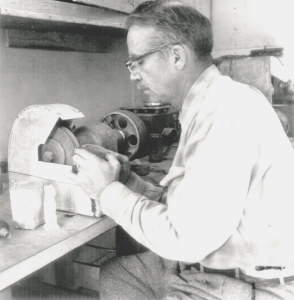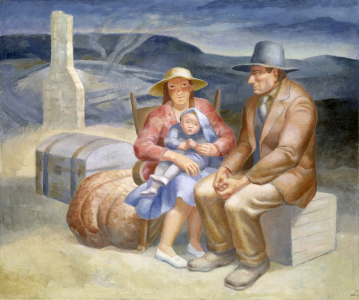
Biography
An obituary for Frank Weathers Long described him as an artist, an athlete, a designer-craftsman, and an author. Born in Knoxville, TN in 1906, he received his early art education from the Art Institute in Chicago and the Pennsylvania Academy of Fine Arts in Philadelphia. An avid runner, he qualified for the U.S. Olympic team in 1928, but chose instead to go to Paris to study at the Academie Julien.
From 1932 to 1942 Long maintained a studio in Berea, KY. His first mural commission (in the early 1930s) was for a private home in Wilmette, IL. Over the next decade he had a number of government mural commissions - more, in fact, than any other artist. These included works for the University of Kentucky Library (1934), the Louisville, KY Courthouse and Custom House (1935), and Post Offices in Hagerstown, MD (1938), Morehead, KY (1939), Berea, KY (1940), Drumright, OK (1941), and Crawfordsville, IN (1942).
Despite this prodigious output - or perhaps as a result of his fatigue with this line of work, Long disparaged murals produced for the Section of Fine Art as "chauvinist American art." He would have preferred to do easel painting, which he took up much later in life.
During World War II, Long was an Army First Lieutenant in the Pacific Theater, painting camoflage. He left the Army in 1946 to study crafts in Silver City, NM. Returning to Berea in 1947, Long established a jewelry workshop. In 1951 the Department of Interior appointed him to the Alaskan Program of the Indian Arts and Crafts Board. From 1958-1961 he directed programs in the Southwest and in Florida, advising tribes on the production and distribution of native arts and crafts.
Long retired from government service in 1969, having been an active member of the Albuquerque Designer-Craftsmen and exhibiting at annual New Mexico arts and crafts fairs. He published two books on lapidary carving, "The Creative Lapidary" (1977) and "Lapidary Carving (1982). In 1989 he finally resumed his preferred medium, easel painting. He published a memoir of his Depression Era career, "Confessions of a Depression Muralist," in 1997. As his health declined in 1997 he moved to Diamondhead, MS, where his daughter and son-in-law resided. He died there in 1999.


Critical Analysis
While Frank Long was one of the most prolific of the painters of Post Office murals, he was acutely aware of the limitations of this art form. For one thing, a painter had to submit to the artistic demands of the judges of the Section of Fine Arts. This sometimes involved modifying a proposed work to fit the Section's aesthetics, whether or not they matched the artist's intent. Secondly, the artist had to fit the artwork into a space provided by the building architect - as opposed to creating a work that might better fit the subject and then finding a space suitable for its hanging. And, finally, the process that was typically employed involved first creating a cartoon of the finished work, transfering the image to canvas, and producing the final copy without any major alterations. To many artists, Long included, this tended to stifle creativity.
Long's favorite murals were his earliest compositions, which were painted more freely than most of his later ones, and his mural for the Berea, KY Post Office. Berea had a special place in Long's heart, and he was willing to put special effort into creation of the mural there. He also painted the mural directly onto the Post Office wall, which provided him with more artistic leeway than he had enjoyed in earlier works.
Murals
- Crawfordsville, Indiana - Post Office: Indiana Agriculture
- Berea, Kentucky - Berea Police and Municipal Center: Berea Commencement in the Old Days
- Lexington, Kentucky - Margaret King Library, University of Kentucky: Labor
- Lexington, Kentucky - Margaret King Library, University of Kentucky: Recreation
- Louisville, Kentucky - Gene Snyder U.S. Courthouse and Custom House: Activities of the Region
- Morehead, Kentucky - Municipal Building: The Rural Free Delivery
- Hagerstown, Maryland - Post Office: Transportation of the Mail
- Drumright, Oklahoma - Post Office: Oklahoma Land Rush
References
- Frank Weathers Long (Find a Grave).
- Abby Houston, Frank Weathers Long, Berea College Hutchins Library July 11 (2016).
- Sue B. Beckham, A Kentucky Artist and a Federal Program: Frank Long and the Treasury Section of Fine Arts, The Kentucky Review Spring (1988).